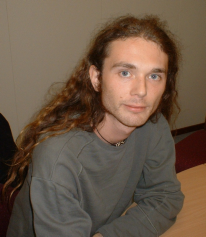High-Speed Low-jitter frequency multiplication in CMOS
Promotion date: 8 January 2004
| Investigations in the IC design sector of Philips’ NatLab, financers of my research, and the IC Design group of the UT nearly all aim at the design of working chips demonstrating a new principle. My chip deals with frequency multiplication. A frequency multiplier or a clock multiplier is a building block which generates a periodical signal in the chip with a frequency that is an exact multiple of that of an incoming reference signal. An important application of this building block is in data communication systems. |
What was your thesis about?
Investigations in the IC design sector of Philips’ NatLab, financers of my research, and the IC Design group of the UT nearly all aim at the design of working chips demonstrating a new principle. My chip deals with frequency multiplication. A frequency multiplier or a clock multiplier is a building block which generates a periodical signal in the chip with a frequency that is an exact multiple of that of an incoming reference signal. An important application of this building block is in data communication systems. To save on costs of physical connections in a large computer network, many data streams are converted into a single serial data stream that can be transmitted over a single glass fibre. To time the individual bits in this high-speed serial data stream, a clock multiplier generates a high-speed clock based on the clock accompanying the parallel data streams. To make sure this data stream can be transmitted over a long distance and still be received with no errors, the timing generated by the clock multiplier needs to be very precise (effects of noise and such should be kept to a minimum).
What is the purpose of again a new chip?
The chip was not directly aimed at a specific product. Its goal was to prove a concept that enables very high clock frequencies to be multiplied, needed for high-speed data communication. As an individual researcher you only contribute a part. And sometimes others work along the same line. That is what I experienced after 1 ½ years, when I read an article of a research that more or less coincided with mine.
So what did you do?
Well, we did not think it was such a good idea to follow in somebody else’s footsteps. That is disappointing somehow. As a researcher, you want something new. So we rephrased the starting points for the research and opted for a different focus.
You sound very philosophical about it, but it surely must have caused a panic?
No, not really. It probably would have if it had happened in the third year, but the first year is your preparatory phase anyhow, in which you make an inventory and acquire the extra knowledge that you will need along the way. So I did not loose too much time and it is much more gratifying to come up with something that others haven’t looked at before. That is the exciting part of research. Now, because of the good and novel ideas that resulted from my research, I had the opportunity to give an oral presentation before an audience of roughly 900 at a prominent congress (the IEEE International Solid-State Circuits Conference in San Francisco, 2003), seeing all these people whose articles you’ve read in the flesh. I was proud of that, and also of the fact that I managed to get two articles published in important journals: one in the IEEE Transactions on Circuits and Systems – II and one in the IEEE Journal of Solid-State Circuits. The fact that you are being published at all in this kind of journals means that your work has quality.
What did you like best in your research?
The enormous freedom. Of course you consult with others, but you set out the lines of the research yourself. I did like that a lot, but now that I am working in a team I find that very enjoyable too.
So you have a job?
Yes, I have a job with Philips doing exactly what I wanted after my PhD, which is continuing to do research. But as I said, now I am working in a team.
And what didn’t you like in your research?
Well, it is not a matter of not liking, but during my research I have been continually aware of the challenge to come up with something new in a field in which a great many researchers are active. And I am very happy that I managed that.

